Dual Mutations in MSMEG_0965 and MSMEG_1380 Confer High-Level Resistance to Bortezomib and Linezolid by Both Reducing Drug Intake and Increasing Efflux in Mycobacterium smegmatis
Abstract
1. Introduction
2. Results
2.1. High Frequency of Spontaneous Mutations Conferring BTZ Resistance in Msm
2.2. WGS of BTZ-Resistant Msm Strains Revealed a Variety of Mutations Across Different Genes
2.3. BTZ-Resistant Msm Strains Exhibited Cross-Resistance to Other Antibiotics
2.4. Single Knockout of MSMEG_1380 or MSMEG_0965 in Msm Resulted in Low-Level Resistance to BTZ and LZD
2.5. Single Knockout of MSMEG_1380 or MSMEG_0965 in Msm Affected the Sensitivity to Other Antibiotics
2.6. Overexpression of MSMEG_1380 or MSMEG_0965 in Msm and Complementation of These Genes in Knockout Strains Affected the Drug Sensitivity to BTZ and LZD
2.7. Roles of MSMEG_138012insC and MSMEG_0965400insCC in Multidrug Resistance Were Confirmed by Gene Editing in Msm
2.8. Dual Mutations of MSMEG_1380 and MSMEG_0965 in Msm Exhibited High-Level Resistance to BTZ and LZD
2.9. The Knockout and Mutation of MSMEG_0965 Reduced Cell Wall Permeability
2.10. The Knockout and Mutation of MSMEG_1380 Upregulate the Expression of the mmpS5-mmpL5 Efflux System
3. Discussion
4. Materials and Methods
4.1. Strains, Plasmids, and Culture Conditions
4.2. Screening for Spontaneous BTZ-Resistant Msm Strains
4.3. Construction of Knockout Strains
4.4. Construction of Overexpression and Complementation Strains
4.5. Construction of Gene Editing Strains
4.6. DST
4.7. Cell Wall Permeability Assay
4.8. RNA Isolation and qRT-PCR
Supplementary Materials
Author Contributions
Funding
Institutional Review Board Statement
Informed Consent Statement
Data Availability Statement
Acknowledgments
Conflicts of Interest
References
- World Health Organization. Global Tuberculosis Report 2024; World Health Organization: Geneva, Switzerland, 2024. [Google Scholar]
- Dheda, K.; Mirzayev, F.; Cirillo, D.M.; Udwadia, Z.; Dooley, K.E.; Chang, K.-C.; Omar, S.V.; Reuter, A.; Perumal, T.; Horsburgh, C.R., Jr.; et al. Multidrug-resistant tuberculosis. Nat. Rev. Dis. Primers 2024, 10, 22. [Google Scholar] [CrossRef] [PubMed]
- Zhang, X.; Zhao, R.; Qi, Y.; Yan, X.; Qi, G.; Peng, Q. The progress of Mycobacterium tuberculosis drug targets. Front. Med. 2024, 11, 1455715. [Google Scholar] [CrossRef] [PubMed]
- Moreira, W.; Ngan Grace, J.Y.; Low Jian, L.; Poulsen, A.; Chia Brian, C.S.; Ang Melgious, J.Y.; Yap, A.; Fulwood, J.; Lakshmanan, U.; Lim, J.; et al. Target mechanism-based whole-cell screening identifies bortezomib as an inhibitor of caseinolytic protease in mycobacteria. mBio 2015, 6, e00253-15. [Google Scholar] [CrossRef] [PubMed]
- Alcalá, L.; Ruiz-Serrano, M.J.; Pérez-Fernández Turégano, C.; García De Viedma, D.; Díaz-Infantes, M.; Marín-Arriaza, M.; Bouza, E. In vitro activities of linezolid against clinical isolates of Mycobacterium tuberculosis that are susceptible or resistant to first-line antituberculous drugs. Antimicrob. Agents Chemother. 2003, 47, 416–417. [Google Scholar] [CrossRef]
- Ahmad, M.N.; Aurooz, F.; Singh, V. Clp protease complex as a therapeutic target for tuberculosis. In Bacterial Enzymes as Targets for Drug Discovery; Elsevier: Amsterdam, The Netherlands, 2025; pp. 363–385. [Google Scholar]
- Sander, P.; Belova, L.; Kidan, Y.G.; Pfister, P.; Mankin, A.S.; Böttger, E.C. Ribosomal and non-ribosomal resistance to oxazolidinones: Species-specific idiosyncrasy of ribosomal alterations. Mol. Microbiol. 2002, 46, 1295–1304. [Google Scholar] [CrossRef]
- Moreira, W.; Santhanakrishnan, S.; Dymock, B.W.; Dick, T. Bortezomib warhead-switch confers dual activity against mycobacterial caseinolytic protease and proteasome and selectivity against human proteasome. Front. Microbiol. 2017, 8, 746. [Google Scholar] [CrossRef]
- Lupoli, T.J.; Vaubourgeix, J.; Burns-Huang, K.; Gold, B. Targeting the proteostasis network for mycobacterial drug discovery. ACS Infect. Dis. 2018, 4, 478–498. [Google Scholar] [CrossRef]
- Hu, G.; Lin, G.; Wang, M.; Dick, L.; Xu, R.; Nathan, C.; Li, H. Structure of the Mycobacterium tuberculosis proteasome and mechanism of inhibition by a peptidyl boronate. Mol. Microbiol. 2006, 59, 1417–1428. [Google Scholar] [CrossRef]
- Moreira, W.; Santhanakrishnan, S.; Ngan, G.J.Y.; Low, C.B.; Sangthongpitag, K.; Poulsen, A.; Dymock, B.W.; Dick, T. Towards selective mycobacterial ClpP1P2 inhibitors with reduced activity against the human proteasome. Antimicrob. Agents Chemother. 2017, 61, e02307–e02316. [Google Scholar] [CrossRef]
- Lin, G.; Hu, G.; Tsu, C.; Kunes, Y.Z.; Li, H.; Dick, L.; Parsons, T.; Li, P.; Chen, Z.; Zwickl, P.; et al. Mycobacterium tuberculosis prcBA genes encode a gated proteasome with broad oligopeptide specificity. Mol. Microbiol. 2006, 59, 1405–1416. [Google Scholar] [CrossRef]
- Kadura, S.; King, N.; Nakhoul, M.; Zhu, H.; Theron, G.; Köser, C.U.; Farhat, M. Systematic review of mutations associated with resistance to the new and repurposed Mycobacterium tuberculosis drugs bedaquiline, clofazimine, linezolid, delamanid and pretomanid. J. Antimicrob. Chemother. 2020, 75, 2031–2043. [Google Scholar] [CrossRef] [PubMed]
- Gan, W.; Ng, H.F.; Ngeow, Y.F. Mechanisms of linezolid resistance in mycobacteria. Pharmaceuticals 2023, 16, 784. [Google Scholar] [CrossRef] [PubMed]
- Ye, M.; Xu, L.; Zou, Y.; Li, B.; Guo, Q.; Zhang, Y.; Zhan, M.; Xu, B.; Yu, F.; Zhang, Z.; et al. Molecular analysis of linezolid-resistant clinical isolates of Mycobacterium abscessus. Antimicrob. Agents Chemother. 2019, 63, e01842-18. [Google Scholar] [CrossRef] [PubMed]
- He, J.; Gao, Y.; Wang, J.; Hameed, H.M.A.; Wang, S.; Fang, C.; Tian, X.; Zhang, J.; Han, X.; Ju, Y.; et al. EmbB and EmbC regulate the sensitivity of Mycobacterium abscessus to echinomycin. mLife 2024, 3, 459–470. [Google Scholar] [CrossRef]
- Wang, S.; Cai, X.; Yu, W.; Zeng, S.; Zhang, J.; Guo, L.; Gao, Y.; Lu, Z.; Hameed, H.M.A.; Fang, C.; et al. Arabinosyltransferase C mediates multiple drugs intrinsic resistance by altering cell envelope permeability in Mycobacterium abscessus. Microbiol. Spectr. 2022, 10, e0276321. [Google Scholar] [CrossRef]
- Fang, C.; Zhang, H.; He, J.; Tian, X.; Zeng, S.; Han, X.; Wang, S.; Yusuf, B.; Hu, J.; Zhong, N.; et al. GrcC1 mediates low-level resistance to multiple drugs in M. marinum, M. abscessus, and M. smegmatis. Microbiol. Spectr. 2025, 13, e02289-24. [Google Scholar] [CrossRef]
- Nasiri, M.J.; Haeili, M.; Ghazi, M.; Goudarzi, H.; Pormohammad, A.; Imani Fooladi, A.A.; Feizabadi, M.M. New insights in to the intrinsic and acquired drug resistance mechanisms in mycobacteria. Front. Microbiol. 2017, 8, 681. [Google Scholar] [CrossRef]
- Richard, M.; Gutiérrez, A.V.; Viljoen, A.J.; Ghigo, E.; Blaise, M.; Kremer, L. Mechanistic and structural insights into the unique TetR-dependent regulation of a drug efflux pump in Mycobacterium abscessus. Front. Microbiol. 2018, 9, 649. [Google Scholar] [CrossRef]
- Salini, S.; Muralikrishnan, B.; Bhat, S.G.; Ghate, S.D.; Rao, R.S.P.; Kumar, R.A.; Kurthkoti, K. Overexpression of a membrane transport system MSMEG_1381 and MSMEG_1382 confers multidrug resistance in Mycobacterium smegmatis. Microb. Pathog. 2023, 185, 106384. [Google Scholar] [CrossRef]
- Maslov, D.A.; Shur, K.V.; Vatlin, A.A.; Danilenko, V.N. MmpS5-MmpL5 transporters provide Mycobacterium smegmatis resistance to imidazo [1,2-b][1,2,4,5]tetrazines. Pathogens 2020, 9, 166. [Google Scholar] [CrossRef]
- Stahl, C.; Kubetzko, S.; Kaps, I.; Seeber, S.; Engelhardt, H.; Niederweis, M. MspA provides the main hydrophilic pathway through the cell wall of Mycobacterium smegmatis. Mol. Microbiol. 2001, 40, 451–464. [Google Scholar] [CrossRef] [PubMed]
- Lambert, P.A. Cellular impermeability and uptake of biocides and antibiotics in gram-positive bacteria and mycobacteria. Symp. Ser. Soc. Appl. Microbiol. 2002, 92, 46S–54S. [Google Scholar] [CrossRef]
- Danilchanka, O.; Pavlenok, M.; Niederweis, M. Role of porins for uptake of antibiotics by Mycobacterium smegmatis. Antimicrob. Agents Chemother. 2008, 52, 3127–3134. [Google Scholar] [CrossRef] [PubMed]
- Gygli, S.M.; Borrell, S.; Trauner, A.; Gagneux, S. Antimicrobial resistance in Mycobacterium tuberculosis: Mechanistic and evolutionary perspectives. FEMS Microbiol. Rev. 2017, 41, 354–373. [Google Scholar] [CrossRef] [PubMed]
- Snapper, S.B.; Melton, R.E.; Mustafa, S.; Kieser, T.; Jacobs, W.R., Jr. Isolation and characterization of efficient plasmid transformation mutants of Mycobacterium smegmatis. Mol. Microbiol. 1911, 4, 1911–1919. [Google Scholar] [CrossRef]
- Hillemann, D.; Rüsch-Gerdes, S.; Richter, E. In vitro-selected linezolid-resistant Mycobacterium tuberculosis mutants. Antimicrob. Agents Chemother. 2008, 52, 800–801. [Google Scholar] [CrossRef]
- Yan, M.; Yan, H.; Ren, G.; Zhao, J.; Guo, X.; Sun, Y. CRISPR-Cas12a-assisted recombineering in bacteria. Appl. Environ. Microbiol. 2017, 83, e00947-17. [Google Scholar] [CrossRef]
- Gaurav, A.; Bakht, P.; Saini, M.; Pandey, S.; Pathania, R. Role of bacterial efflux pumps in antibiotic resistance, virulence, and strategies to discover novel efflux pump inhibitors. Microbiology 2023, 169, 001333. [Google Scholar] [CrossRef]
- Sui, X.; Guo, L.; Bao, Z.; Xian, M.; Zhao, G. Efflux pumps and porins enhance bacterial tolerance to phenolic compounds by inhibiting hydroxyl radical generation. Microorganisms 2025, 13, 202. [Google Scholar] [CrossRef]
- Niederweis, M. Mycobacterial porins—New channel proteins in unique outer membranes. Mol. Microbiol. 2003, 49, 1167–1177. [Google Scholar] [CrossRef]
- Purdy, G.E.; Niederweis, M.; Russell, D.G. Decreased outer membrane permeability protects mycobacteria from killing by ubiquitin-derived peptides. Mol. Microbiol. 2009, 73, 844–857. [Google Scholar] [CrossRef] [PubMed]
- Rodrigues, L.; Ramos, J.; Couto, I.; Amaral, L.; Viveiros, M. Ethidium bromide transport across Mycobacterium smegmatis cell-wall: Correlation with antibiotic resistance. BMC Microbiol. 2011, 11, 35. [Google Scholar] [CrossRef] [PubMed]
- Dheda, K.; Gumbo, T.; Maartens, G.; Dooley, K.E.; McNerney, R.; Murray, M.; Furin, J.; Nardell, E.A.; London, L.; Lessem, E.; et al. The epidemiology, pathogenesis, transmission, diagnosis, and management of multidrug-resistant, extensively drug-resistant, and incurable tuberculosis. Lancet Respir. Med. 2017, 5, P291–P360. [Google Scholar] [CrossRef] [PubMed]
- Hameed, H.M.A.; Fang, C.; Liu, Z.; Ju, Y.; Han, X.; Gao, Y.; Wang, S.; Chiwala, G.; Tan, Y.; Guan, P.; et al. Characterization of genetic variants associated with rifampicin resistance level in Mycobacterium tuberculosis clinical isolates collected in Guangzhou Chest Hospital, China. Infect. Drug Resist. 2022, 15, 5655–5666. [Google Scholar] [CrossRef]
- Mailaender, C.; Reiling, N.; Engelhardt, H.; Bossmann, S.; Ehlers, S.; Niederweis, M. The MspA porin promotes growth and increases antibiotic susceptibility of both Mycobacterium bovis BCG and Mycobacterium tuberculosis. Microbiology 2004, 150, 853–864. [Google Scholar] [CrossRef]
- Sonnenkalb, L.; Carter, J.; Spitaleri, A.; Iqbal, Z.; Hunt, M.; Malone, K.; Utpatel, C.; Cirillo, D.M.; Rodrigues, C.; Nilgiriwala, K.S.; et al. Deciphering bedaquiline and clofazimine resistance in tuberculosis: An evolutionary medicine approach. bioRxiv 2021. [Google Scholar] [CrossRef]
- Ismail, N.; Rivière, E.; Limberis, J.; Huo, S.; Metcalfe, J.Z.; Warren, R.M.; Van Rie, A. Genetic variants and their association with phenotypic resistance to bedaquiline in Mycobacterium tuberculosis: A systematic review and individual isolate data analysis. Lancet Microbe 2021, 2, e604–e616. [Google Scholar] [CrossRef]
- Guo, Q.; Chen, J.; Zhang, S.; Zou, Y.; Zhang, Y.; Huang, D.; Zhang, Z.; Li, B.; Chu, H. Efflux pumps contribute to intrinsic clarithromycin resistance in clinical, Mycobacterium abscessus isolates. Infect. Drug Resist. 2020, 13, 447–454. [Google Scholar] [CrossRef]
- Palmer, A.C.; Kishony, R. Opposing effects of target overexpression reveal drug mechanisms. Nat. Commun. 2014, 5, 4296. [Google Scholar] [CrossRef]
- Singh, R.; Dwivedi, S.P.; Gaharwar, U.S.; Meena, R.; Rajamani, P.; Prasad, T. Recent updates on drug resistance in Mycobacterium tuberculosis. J. Appl. Microbiol. 2020, 128, 1547–1567. [Google Scholar] [CrossRef]
- Gifford, D.R.; Berríos-Caro, E.; Joerres, C.; Suñé, M.; Forsyth, J.H.; Bhattacharyya, A.; Galla, T.; Knight, C.G. Mutators can drive the evolution of multi-resistance to antibiotics. PLoS Genet. 2023, 19, e1010791. [Google Scholar] [CrossRef] [PubMed]
- Igler, C.; Rolff, J.; Regoes, R. Multi-step vs. single-step resistance evolution under different drugs, pharmacokinetics, and treatment regimens. eLife 2021, 10, e64116. [Google Scholar] [CrossRef] [PubMed]
- Nimmo, C.; Ortiz, A.T.; Tan, C.C.S.; Pang, J.; Acman, M.; Millard, J.; Padayatchi, N.; Grant, A.D.; O’Donnell, M.; Pym, A.; et al. Detection of a historic reservoir of bedaquiline/clofazimine resistance-associated variants in Mycobacterium tuberculosis. Genome Med. 2024, 16, 34. [Google Scholar] [CrossRef] [PubMed]
- Hartkoorn, R.C.; Uplekar, S.; Cole, S.T. Cross-resistance between clofazimine and bedaquiline through upregulation of MmpL5 in Mycobacterium tuberculosis. Antimicrob. Agents Chemother. 2014, 58, 2979–2981. [Google Scholar] [CrossRef]
- Negatu, D.A.; Aragaw, W.W.; Dartois, V.; Dick, T. Characterization of in vitro resistance to linezolid in Mycobacterium abscessus. Microbiol. Spectr. 2023, 11, e02199-23. [Google Scholar] [CrossRef]
- Niederweis, M.; Ehrt, S.; Heinz, C.; Klöcker, U.; Karosi, S.; Swiderek, K.M.; Riley, L.W.; Benz, R. Cloning of the mspA gene encoding a porin from Mycobacterium smegmatis. Mol. Microbiol. 1999, 33, 933–945. [Google Scholar] [CrossRef]
- Siroy, A.; Mailaender, C.; Harder, D.; Koerber, S.; Wolschendorf, F.; Danilchanka, O.; Wang, Y.; Heinz, C.; Niederweis, M. Rv1698 of Mycobacterium tuberculosis represents a new class of channel-forming outer membrane proteins. J. Biol. Chem. 2008, 283, 17827–17837. [Google Scholar] [CrossRef]
- Li, X.; Zhang, L.; Poole, K. Interplay between the MexA-MexB-OprM multidrug efflux system and the outer membrane barrier in the multiple antibiotic resistance of Pseudomonas aeruginosa. J. Antimicrob. Chemother. 2000, 45, 433–436. [Google Scholar] [CrossRef]
- Lewis, J.S., II; Clinical and Laboratory Standards Institute. Performance Standards for Antimicrobial Susceptibility Testing; Clinical and Laboratory Standards Institute: Wayne, PA, USA, 2023. [Google Scholar]
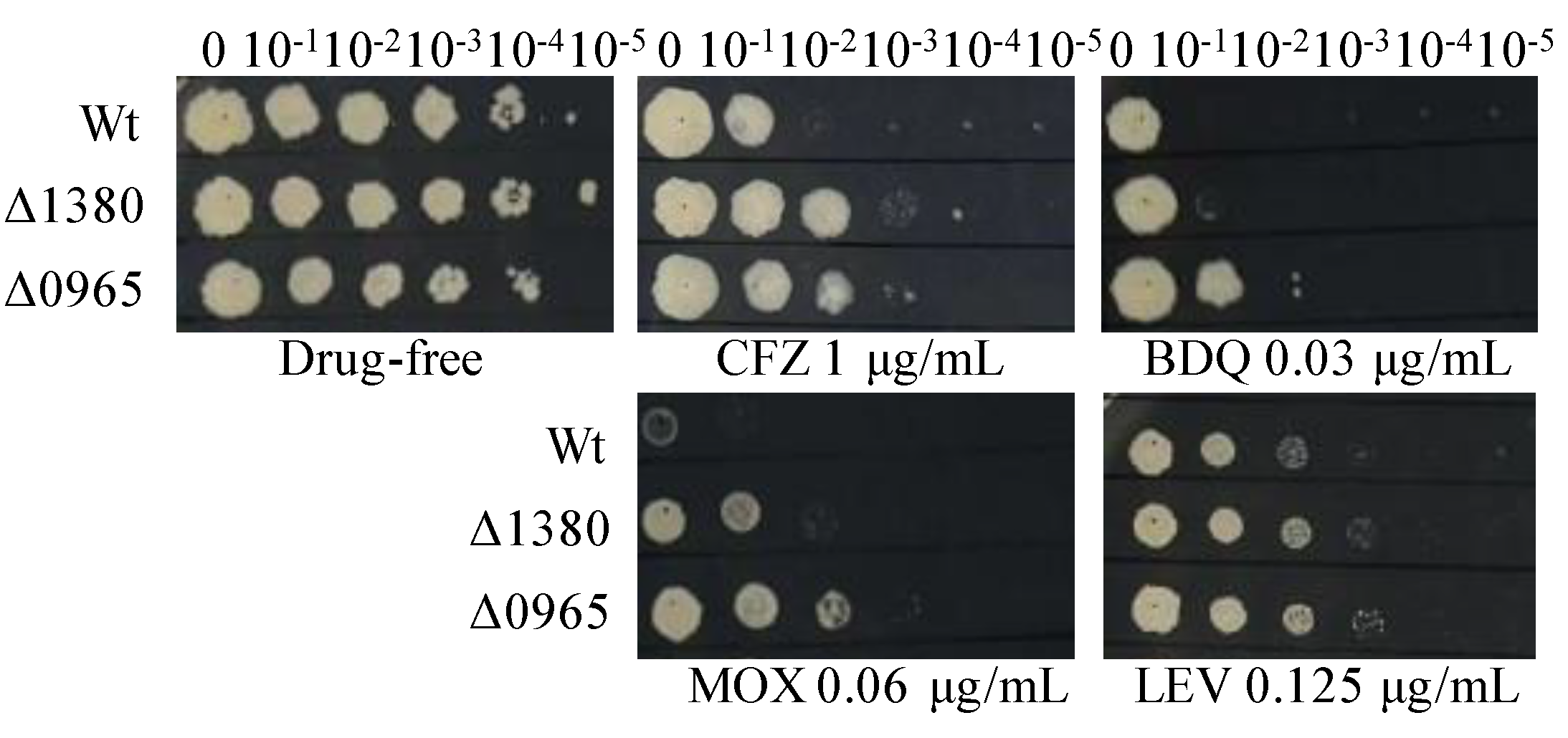
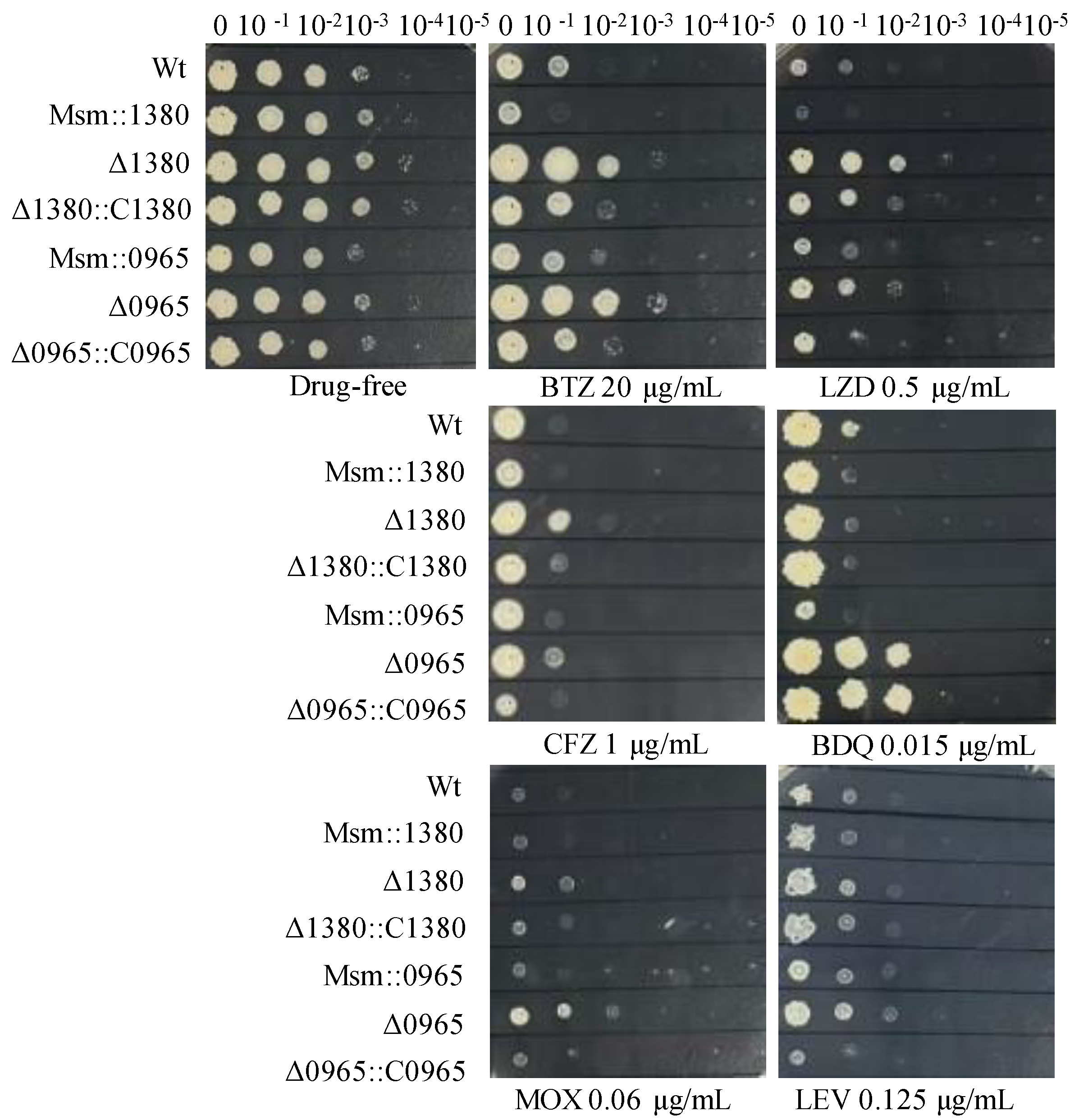
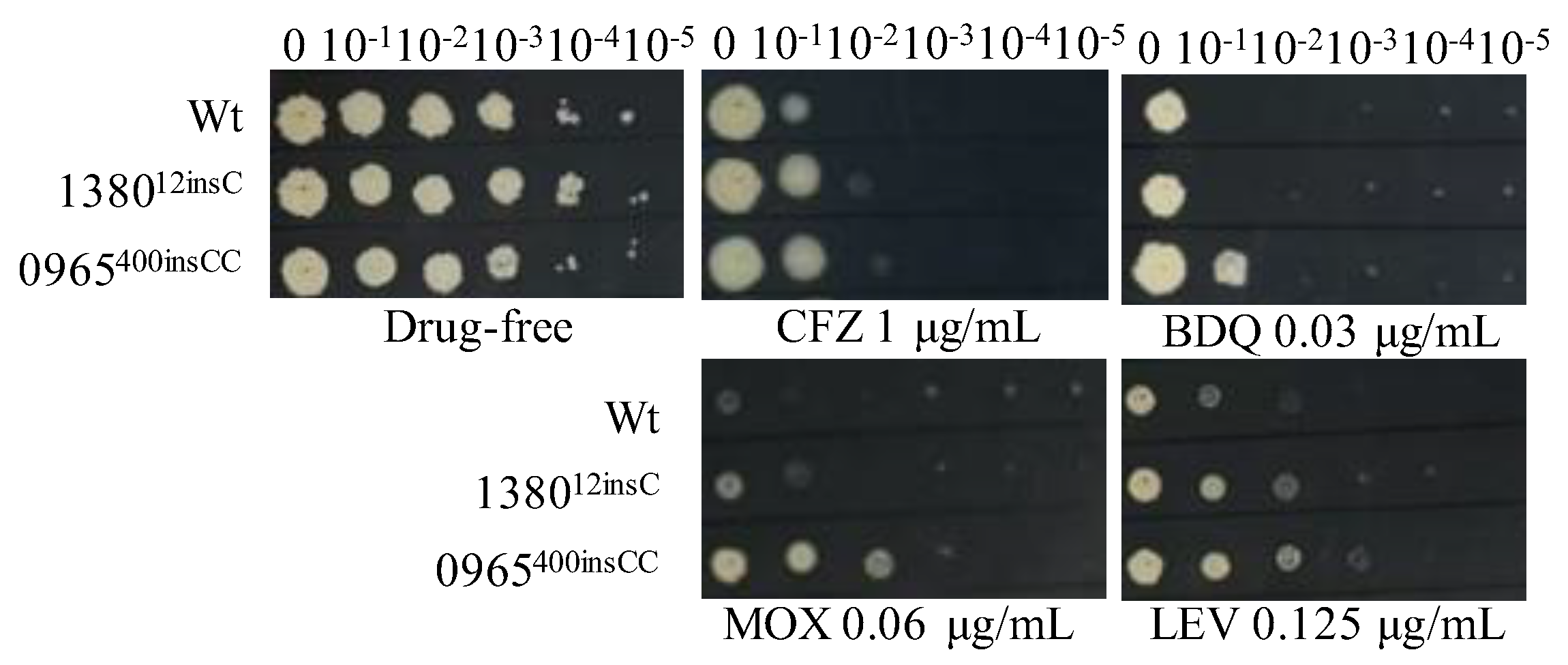
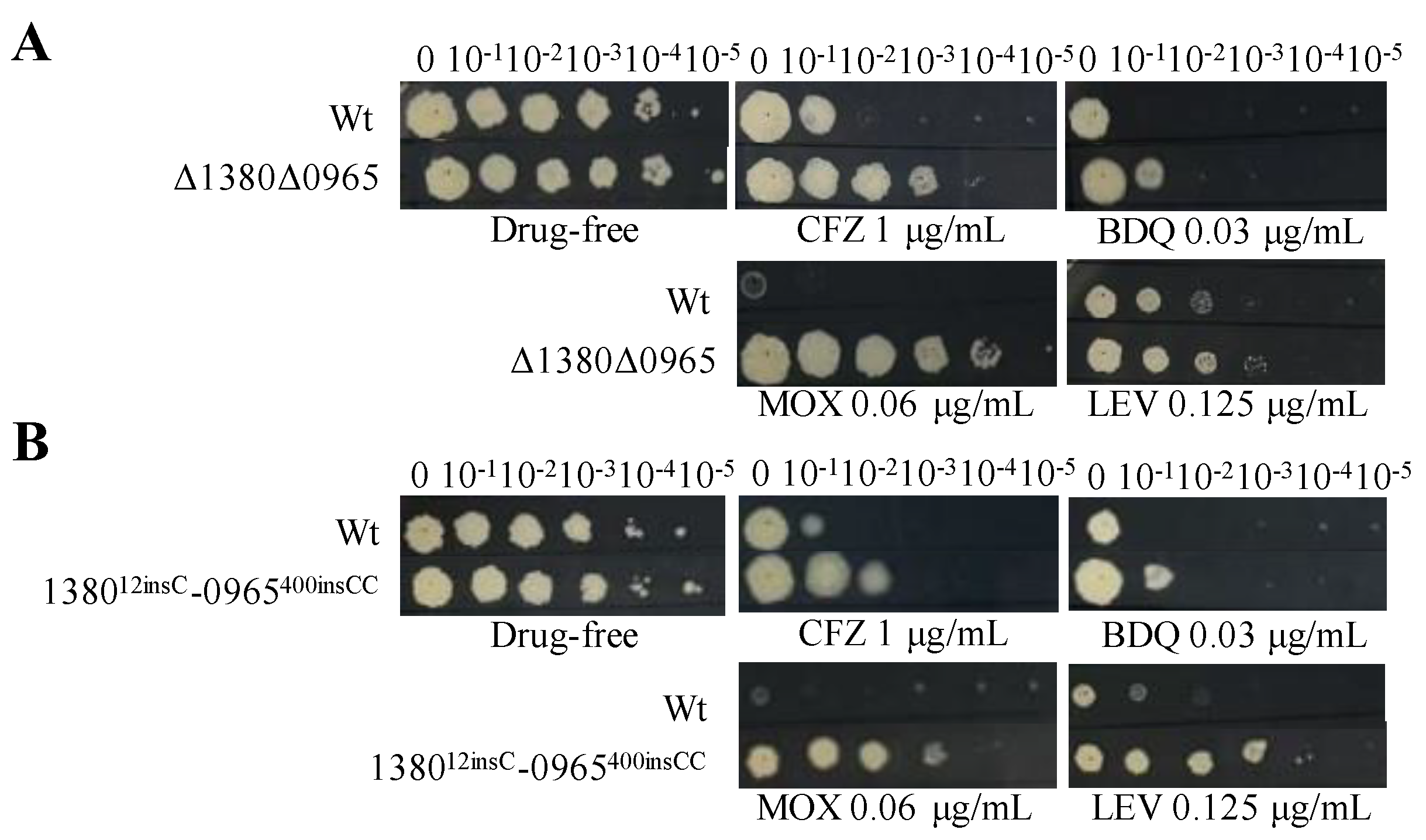

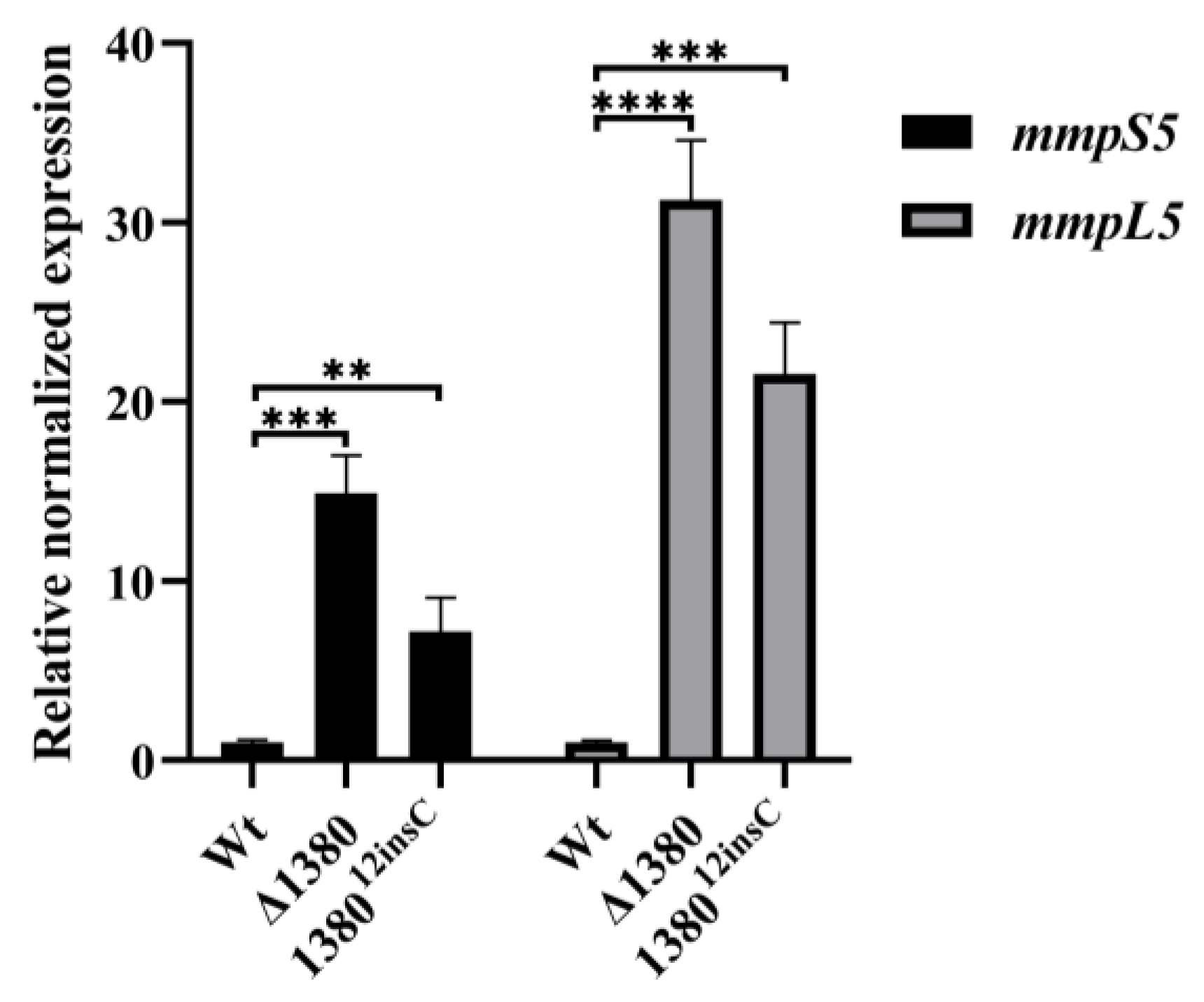
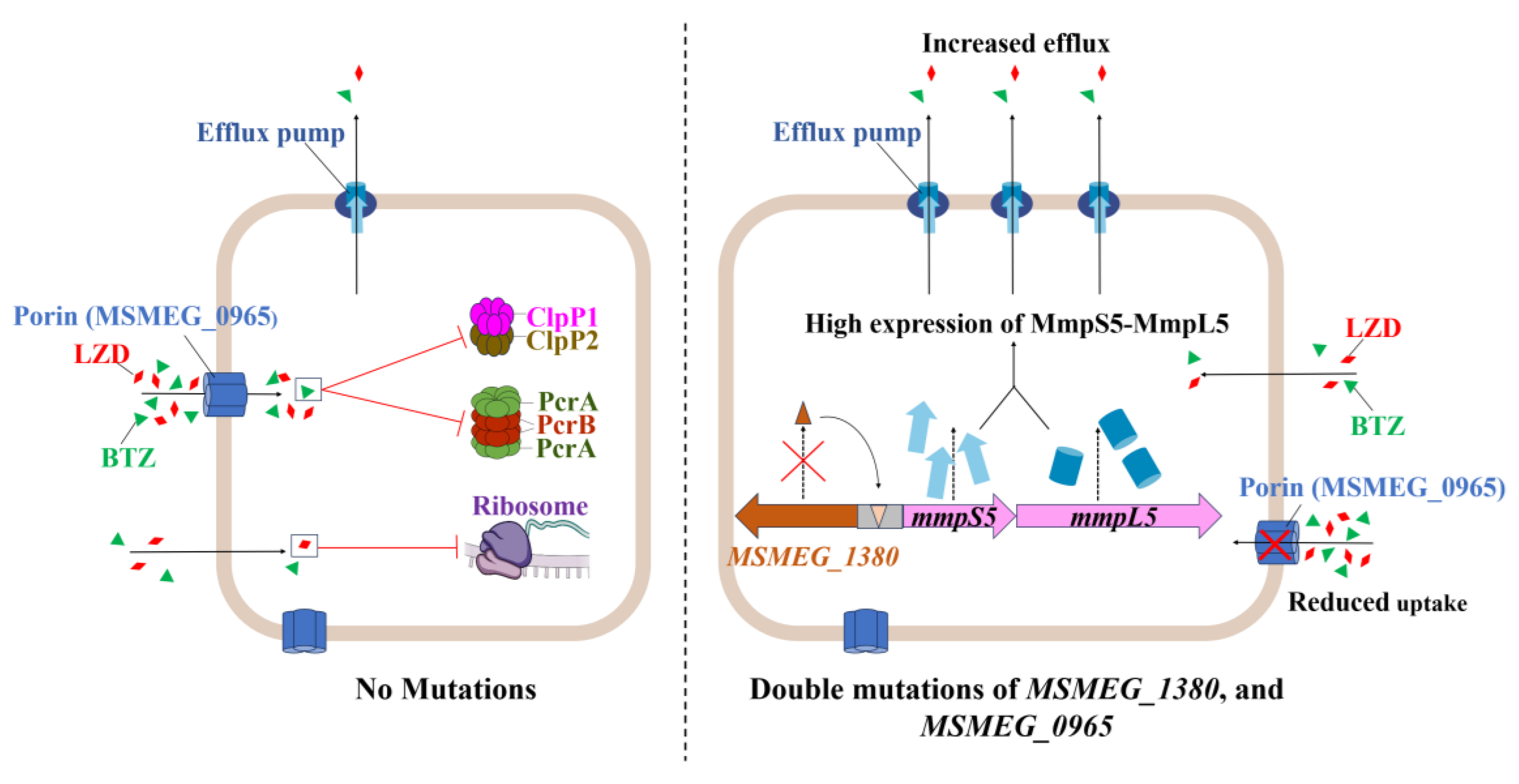
| Strains | MICs (μg/mL)/Fold Change | |||||||
|---|---|---|---|---|---|---|---|---|
| BTZ | LZD | CLR | EMB | GEN | LEV | AMK | STR | |
| Wt | 5/1 | 2/1 | 1/1 | 1/1 | 2/1 | 0.25/1 | 0.5/1 | 0.5/1 |
| Msm-R1-2 # | 80/16 | 128/64 | 4/4 | 2/2 | 2/1 | 0.25/1 | 0.5/1 | 0.25/0.5 |
| Msm-R1-13 # | >80/>16 | 4/2 | 8/8 | 1/1 | 8/4 | 0.25/1 | 0.5/1 | 0.25/0.5 |
| Msm-R3-2 # | 80/16 | 4/2 | 2/2 | 2/2 | 4/2 | 0.25/1 | 0.5/1 | 1/2 |
| Msm-R4-1 # | 80/16 | 2/1 | 2/2 | 4/4 | 1/0.5 | 0.5/2 | 0.5/1 | 0.5/1 |
| Msm-R4-7 # | 80/16 | 2/1 | 1/1 | 1/1 | 1/0.5 | 0.5/2 | 1/2 | 0.5/1 |
| Strains | MIC (μg/mL)/Fold Change |
|---|---|
| Wt | 5/1 |
| Δ3244 | 5/1 |
| Δ5085 | 5/1 |
| Δ3987 | 5/1 |
| Δ1380 | 20/4 |
| Δ0965 | 20/4 |
| Strains | MIC (μg/mL)/Fold Change |
|---|---|
| Wt | 2/1 |
| Δ1380 | 8/4 |
| Δ0965 | 8/4 |
| Strains | MICs (μg/mL)/Fold Change | |||
|---|---|---|---|---|
| VAN | CLR | SDZ | SMX | |
| Wt | 8/1 | 2/1 | 2/1 | 1/1 |
| Δ1380 | 32/4 | 2/1 | 2/1 | 1/1 |
| Δ0965 | 32/4 | 16/16 | 8/4 | 16/16 |
| Strains | MICs (μg/mL)/Fold Change | |||||
|---|---|---|---|---|---|---|
| BTZ | LZD | VAN | CLR | SDZ | SMX | |
| Wt | 5/1 | 2/1 | 8/1 | 2/1 | 2/1 | 1/1 |
| 138012insC | 20/4 | 8/4 | 32/4 | 2/1 | 2/1 | 1/1 |
| 0965400insCC | 20/4 | 8/4 | 32/4 | 16/8 | 8/4 | 16/16 |
| Strains | MICs (μg/mL)/Fold Change | |||||
|---|---|---|---|---|---|---|
| BTZ | LZD | VAN | CLR | SDZ | SMX | |
| Wt | 5/1 | 2/1 | 8/1 | 2/1 | 2/1 | 1/1 |
| Δ1380Δ0965 | 80/16 | 128/64 | 128/16 | 16/8 | 16/8 | 16/16 |
| 138012insC-0965400insCC | 80/16 | 128/64 | 128/16 | 16/8 | 16/8 | 16/16 |
| Δ1380Δ0965::C1380C0965 | 80/16 | 128/64 | 128/16 | 16/8 | 16/8 | 16/16 |
Disclaimer/Publisher’s Note: The statements, opinions and data contained in all publications are solely those of the individual author(s) and contributor(s) and not of MDPI and/or the editor(s). MDPI and/or the editor(s) disclaim responsibility for any injury to people or property resulting from any ideas, methods, instructions or products referred to in the content. |
© 2025 by the authors. Licensee MDPI, Basel, Switzerland. This article is an open access article distributed under the terms and conditions of the Creative Commons Attribution (CC BY) license (https://creativecommons.org/licenses/by/4.0/).
Share and Cite
Zhang, H.; Fang, C.; Yusuf, B.; Zhu, X.; Wang, S.; Hameed, H.M.A.; Gao, Y.; Zhang, T. Dual Mutations in MSMEG_0965 and MSMEG_1380 Confer High-Level Resistance to Bortezomib and Linezolid by Both Reducing Drug Intake and Increasing Efflux in Mycobacterium smegmatis. Int. J. Mol. Sci. 2025, 26, 3779. https://doi.org/10.3390/ijms26083779
Zhang H, Fang C, Yusuf B, Zhu X, Wang S, Hameed HMA, Gao Y, Zhang T. Dual Mutations in MSMEG_0965 and MSMEG_1380 Confer High-Level Resistance to Bortezomib and Linezolid by Both Reducing Drug Intake and Increasing Efflux in Mycobacterium smegmatis. International Journal of Molecular Sciences. 2025; 26(8):3779. https://doi.org/10.3390/ijms26083779
Chicago/Turabian StyleZhang, Han, Cuiting Fang, Buhari Yusuf, Xiaoqing Zhu, Shuai Wang, H. M. Adnan Hameed, Yamin Gao, and Tianyu Zhang. 2025. "Dual Mutations in MSMEG_0965 and MSMEG_1380 Confer High-Level Resistance to Bortezomib and Linezolid by Both Reducing Drug Intake and Increasing Efflux in Mycobacterium smegmatis" International Journal of Molecular Sciences 26, no. 8: 3779. https://doi.org/10.3390/ijms26083779
APA StyleZhang, H., Fang, C., Yusuf, B., Zhu, X., Wang, S., Hameed, H. M. A., Gao, Y., & Zhang, T. (2025). Dual Mutations in MSMEG_0965 and MSMEG_1380 Confer High-Level Resistance to Bortezomib and Linezolid by Both Reducing Drug Intake and Increasing Efflux in Mycobacterium smegmatis. International Journal of Molecular Sciences, 26(8), 3779. https://doi.org/10.3390/ijms26083779






